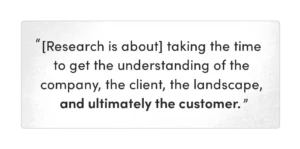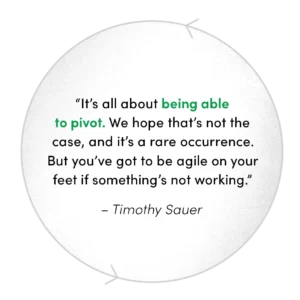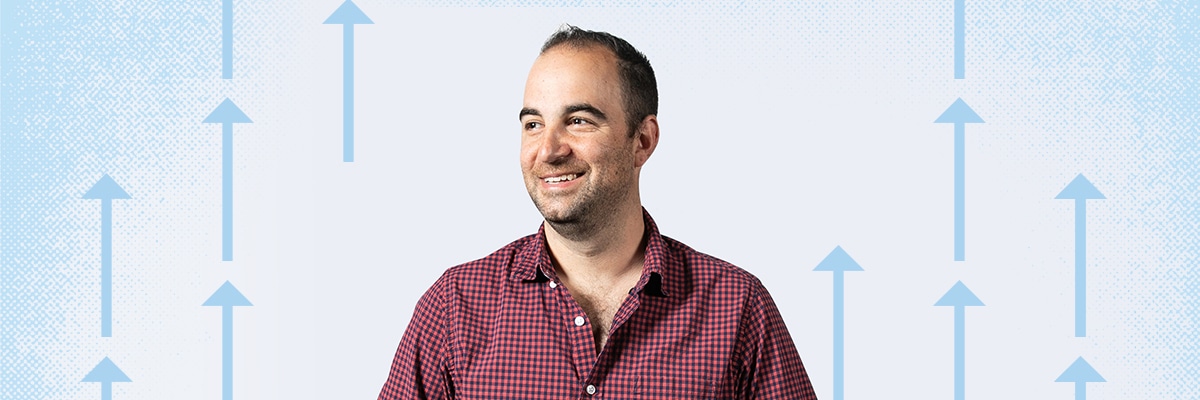Research is the foundation of quality marketing. When our team takes on a client, we let the human insights our in-house research team uncovers lead the project.
Sometimes, we go in a research project with a notion of what the outcome may be. And sometimes, the truth we discover is anything but expected. Those are what we like to call breakthrough insights.
Marketers should approach research with an open mind and let the data lead them to places they haven’t yet imagined. That is where the magic happens.
We sat down with Timothy Sauer, Ph.D., the head of Leap Group’s in-house research team, to discuss research, breakthrough human insights, and letting data lead the project.
*This interview has been edited for length and clarity.
Q: What is the value of research and marketing?
TS: Market research is like the North Star. It’s the jumping off point, the building block for strategy, and what we essentially measure all execution against.

Because we’re all talented marketers, we can have our own hypotheses or guesses [going into a project] — but none of that really matters, unless we know what matters to the consumer. We can have great, brilliant ideas for creative, but if we don’t understand the consumer and what’s going to resonate, we’re taking a shot in the dark. To put the best foot forward, we should begin with research.
It doesn’t have to be a huge lift. It’s more than just checking the boxes. [Research is about] taking the time to get the understanding of the company, the client, the landscape, and ultimately the customer.
Q: Does every project start with research?
TS: Ideally, every project starts with research.
Typically, at a minimum, [we like] to at least have stakeholder calls before we go and execute anything. The goal is to talk to those key stakeholders to find out how they frame their needs, goals, what they want to get out of whatever they’ve signed with us, what their value proposition is, [what their products or services are], and what they know about their customers.
In addition to the stakeholder interview, we typically do what’s called business alignment, and that’s just gathering data from [the client]. Oftentimes, they already have some sort of foundation [of data and insights] if they’ve been executing or creating their own strategy. Hopefully, there’s remnants or pieces of [research like] personas. Or maybe they’ve done focus groups five or ten years ago, or they’ve done some ongoing customer surveys; that kind of stuff. We ask for all of that, even before stakeholder interviews to find out where the gaps are.
Q: How do you gauge what sort of research you need to do in each project?
TS: [Once we’ve completed the stakeholder interviews and business alignment, we say] let’s go look at how you sit within your vertical and within your competitive set. Let’s go look at what others are doing, what others are saying. Where is the whitespace? How are you positioned within your competitive set? Is there somewhere, within our value proposition, that we think is going to resonate in a way that hasn’t been marketed or positioned before?
The final piece would be, what I think is the most valuable, let’s talk to your consumers. It’s the same for B2B and B2C. Whoever you are trying to market to, let’s talk to them.
Audience research can [include] focus groups, where we spend 90 minutes with a sample of four to six individuals that would be part of your target audience and we’ll talk to them about their consumer journey and what they look for. [Focus groups are] in real time, and we can [pivot] if somebody says something that we hadn’t thought of before.
It can [also include] surveys. The benefit of a survey is a much larger sample, and a lot faster turnaround. But we’re not going to have the depth [of a focus group].
Q: When you approach a new project, do you have a preconceived idea of how it might go?
TS: We go in with full-formed methodology.
Do we know what we’re going to hear, what we’re going to learn? No.
Do we have some notion of what might come out of it? Yes, we do.
Are there times where we’re completely wrong about what we thought about what a client was thinking? Yes, that does happen.
Even from a methodology standpoint — where we are trying to recruit for a niche [and] there’s a lot of trouble incentivizing or getting [participants] to commit [to a study]. We might have to pivot to [another method].
 It’s all about being able to pivot. We hope that’s not the case, and it’s a rare occurrence. But you’ve got to be agile on your feet if something’s not working.
It’s all about being able to pivot. We hope that’s not the case, and it’s a rare occurrence. But you’ve got to be agile on your feet if something’s not working.
One of the more interesting studies we did was on a dating app [startup]. I’ve been married for 13 years. From popular media, I know about dating apps [but not much]. When you start getting into different verticals and industries, we’re going to go in not knowing a hell of a lot, and that’s the fun of it.
Q: Has there ever been a time conducting research where you ran into an opportunity or insight that you did not see coming?
TS: It’s not a measurable goal, but I really like to have that happen at least once every study. It shows depth, that we’ve gotten to something like that. It shows a level of understanding that we’ve gone well beyond what [the client] might have considered.
We worked with a startup that creates stainless steel bottles. It was a new-to-market product. We were doing the initial feasibility study, market positioning, that kind of thing. [We were researching] where are you going to sell it, how are you going to sell it. We looked at the industry and across the board, brands were going after 18 to 34-year-old females in the wellness and fitness vertical. [Other brands were saying], “Hey, take this to yoga, take this to exercise class, when you’re going on a hike.”
What we found when talking to consumers, [some participants] said: “Hey that’s all great, but I don’t see myself in that imagery. I don’t have time for that, seeing people at a music festival with their water bottles. I breastfeed and you get really dehydrated when you breastfeed. It’s encouraged to drink plenty of fluids. Why don’t you show imagery there? If you want a use case, show the bottle with a new mother that’s breastfeeding.”
I was like, holy shit. I never thought about it. Going and looking at the content that was out there, using our social listening tools and manual effort scouring the competitive set, [we found] nobody was playing there.
The [lesson] was, we need to be more inclusive. We [had been] more narrowly focused, and there were real opportunities to broaden the reach and resonate with more people.
Q: Has there ever been a time where you uncovered an issue you did not expect?
TS: A lot of times [that happens] in startups, where they have a product concept, they’ve done some work and their hearts are in it, and they think it’s going to be a great, game-changing thing. You go out and do the research, and we must be honest with them and say this doesn’t seem feasible in this market. We’ll give recommendations. The dating app [I mentioned previously] had that [problem]. There’s so much saturation in the market. You’re just going to be one in a million.
I can think of an example, a healthcare brand we took website mockup creative in front of. They wanted to validate a new design and compare it to an old design [in a focus group], and people preferred the old design.
[The issue] was around the language itself. It was clinical and medical. You’ve got to be careful because some marketing copy is written by healthcare professionals, and they’ll start using terms that the public will say, “I don’t know what that means. It doesn’t resonate with me.”
That’s not fun to give back to the creative team, or to give to the client who’s just invested this time and money. But I’d rather catch it now before it goes live.
What we’re able to do there then is pivot, go back, and make some changes. When we do that research, we aren’t just asking “which one do you like more?” It’s, “Why do you like this one more? What do you not like about this? What can be improved?” So, we come back with a set of recommendations.
Learning from Breakthrough Insights
Research is the North Star of any marketing project. Seasoned professionals can anticipate results, but even the most educated guess is pointless if it doesn’t reflect the voice of the consumer. Research can uncover breakthrough insights in the form of opportunities or issues that can make or break a given project.
If your brand needs assistance in research, we are here to help. To learn more about our in-house research team, 20 years and counting of experience, and how it can work for you, visit our website or contact us for a consultation.

